I2AO Part 4: Observing the Southern Sky
Back to the Index of I2AO (Introduction to Astronomy Online)
PART 4: THE CELESTIAL SPHERE and OBSERVING THE SOUTHERN SKY by Lesa Moore
- The Celestial Sphere
- The Equatorial Coordinate Grid
- Twilight, Twinkling and Which Stars You'll See
- Dark Adaptation, Charts, Planispheres, Yearbooks and Atlases
- City vs. Country
- Eye vs. Camera
- Seasonal Highlights
- Eye vs. Telescope and Averted Vision
- The Zodiac
- Precession of the Equinoxes
- Finding South with the Stars
- Where to Observe From
-----------------------------------------------------
- Although the ancients believed that the celestial sphere was a glassy ball that carried the stars upon it, we know today that the stars and galaxies all lie at different distances from us. However, the concept of a sphere is useful for learning concepts of celestial coordinates and the apparent motions of the Sun and planets.
- Sky-based references:
- The north celestial pole sits at the zenith for an observer at the north geographic pole, likewise for the south. At other latitudes, the elevation of the pole above the horizon corresponds with your latitude south or north of the equator. The celestial poles would be on the horizon if you were at the equator.
- The celestial equator sits above the Earth's geographic equator.
- The Ecliptic is the apparent path of the Sun across the sky. Whilst we see the Sun rise and set each day, this is due to Earth's spin, not the Sun's motion. It takes the Sun one year to complete one full "circuit" with reference to the background stars - this is due to Earth orbiting the Sun, not the Sun actually moving. Thus, the ecliptic also represents the plane of Earth's orbit around the Sun.
- The Milky Way is the galaxy that we live in. We see this spiral galaxy from inside it, so it forms a band right around us. We see different parts of it at different times of year.
Figure 1 below: A modern celestial sphere, marked with the constellations, the Milky Way and the equatorial coordinate grid (discussed further in the next section). Earth is located at the centre of the sphere, as the celestial sphere concept is entirely geocentric (Earth-based). This celestial sphere is shown in the correct orientation for an observer at approximately 35°S latitude (e.g., Sydney, Australia). The red ribbon marks the Ecliptic. The green ribbon marks the plane of the Milky Way. The celestial equator is where the two halves of the plastic sphere join (above Earth's equator). The south celestial pole is in the direction of the projection of Earth's rotational axis through Antarctica and out into space. The horizon is represented by a horizontal plane through the centre of the sphere.
Image Credit: Photo by the Lesa Moore
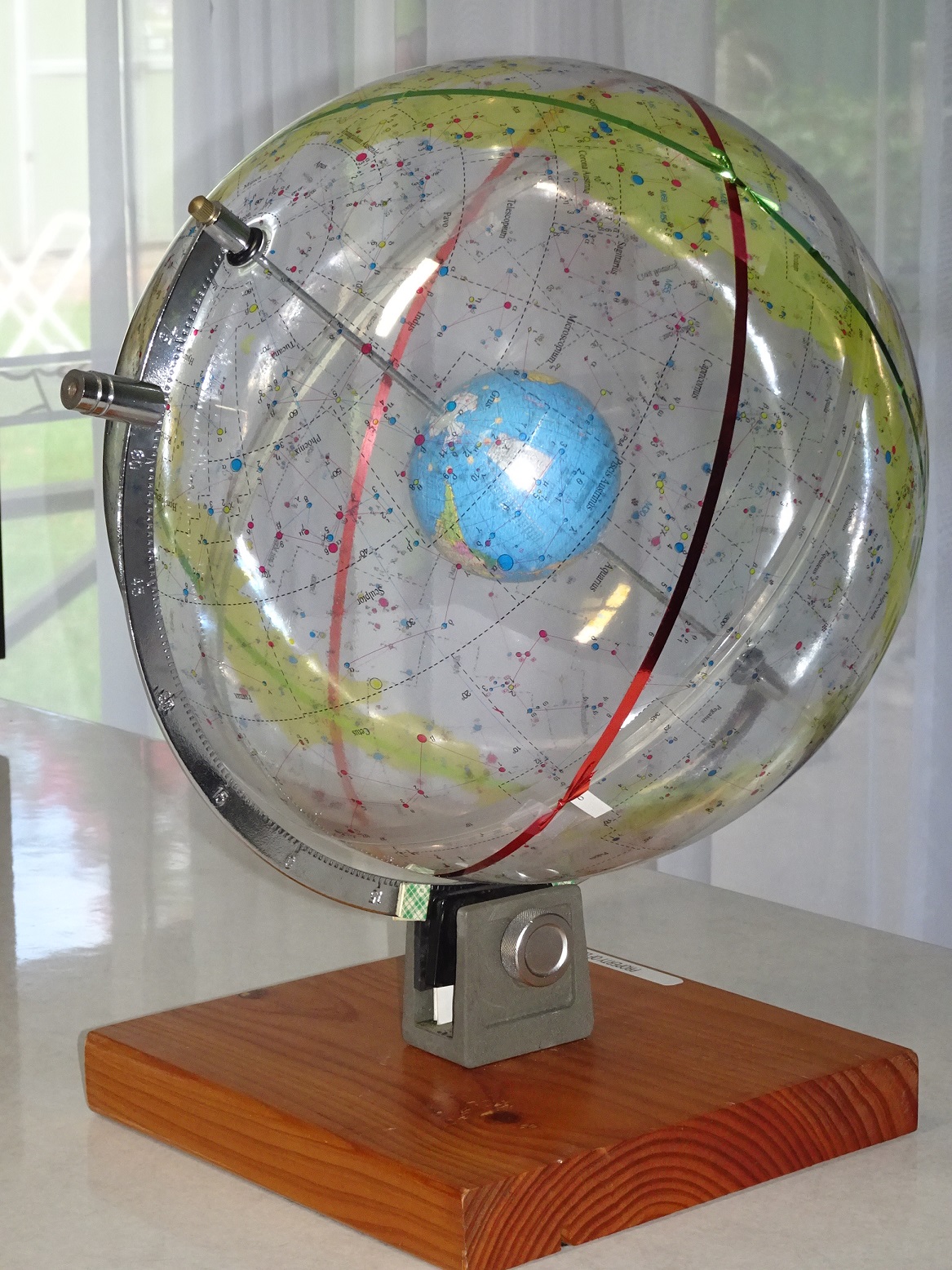
- Observer-based references:
- The meridian is an imaginary line that runs from due north to due south directly overhead for the observer.
- The zenith is the point directly overhead for the observer.
- The Altitude of an object is its angular measure above the horizon from your observing location.
- Direction is just the same as for on the ground - north, south, east, west and all angles in between.
Figure 2 below: This diagram shows the positions of the zenith, the meridian line and an example of a position using altitude and direction.
Image Credit: Pearson Education, publishing as Addison Wesley.
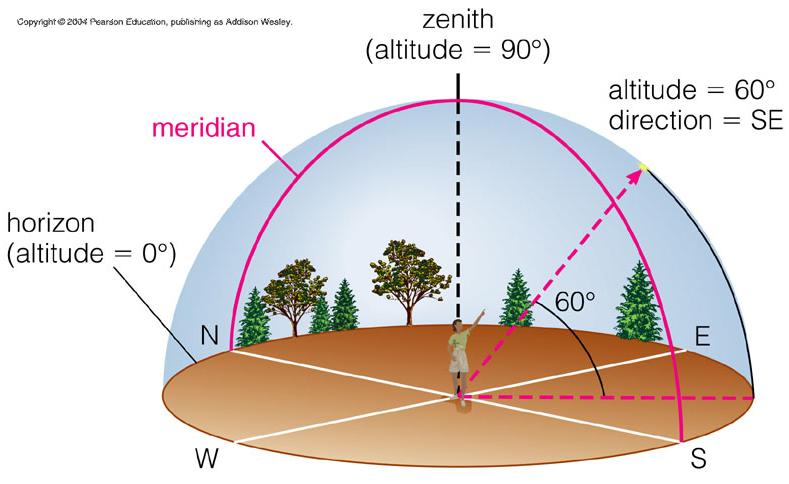
- Just as we can determine a location on the surface of the Earth from longitude and latitude coordinates, the positions of celestial objects are designated according to a celestial grid.
- In astronomy, different coordinate systems are used in different applications:
- Equatorial coordinates of right ascension (RA) and declination (Dec) are generally used for star charts and quoting positions of planets and the Sun (refer next section for details).
- Galactic coordinates are used in specialised applications where it is important to reference data with respect to the plane of the galaxy, e.g. when studying the content of hydrogen gas in the Milky Way's spiral arms.
2. The Equatorial Coordinate Grid
Right Ascension (RA)
- Lines of RA run from pole to pole, like lines of longitude.
- RA is measured in hours, minutes and seconds.
- Just as with time, there are sixty seconds in a minute and sixty minutes in an hour of RA.
- RA progresses eastward from 0h to 24h (equivalent to 360 degrees, so one hour of RA covers 15 degrees). This is in contrast to longitude, which is measured from 0 to 180 degrees E and W of Greenwich.
- If you observe the eastern horizon and the 0h line crosses at a particular position on your horizon then, one hour later, the 1h line of RA will cross that position, and so on. Thus, RA progresses with time.
- The zero line of RA passes through a special point known as The First Point of Aries. At the vernal equinox (the spring equinox for the northern hemisphere or the autumn equinox for us Aussies), the Sun appears to cross the equator from south to north. The position of the Sun at this time is The First Point of Aries. Hence, The First Point of Aries is the intersection of the celestial equator, the ecliptic and the zero line of RA.
Declination (Dec)
- Lines of Dec follow the same pattern as lines of latitude - they run in circles from 0 degrees at the equator to 90 degrees N and S at the poles.
- Dec is measured in degrees, minutes and seconds.
Figure 3 below: This simple diagram depicts the 0 hour of RA (line running from north to south, north is at the top), the celestial equator (the black horizontal line) and the Ecliptic (in green). The direction of the arrow indicates the apparent path of the Sun through the sky. These three lines intersect at a point known as the First Point of Aries.
Image Credit: Diagram by the Lesa Moore
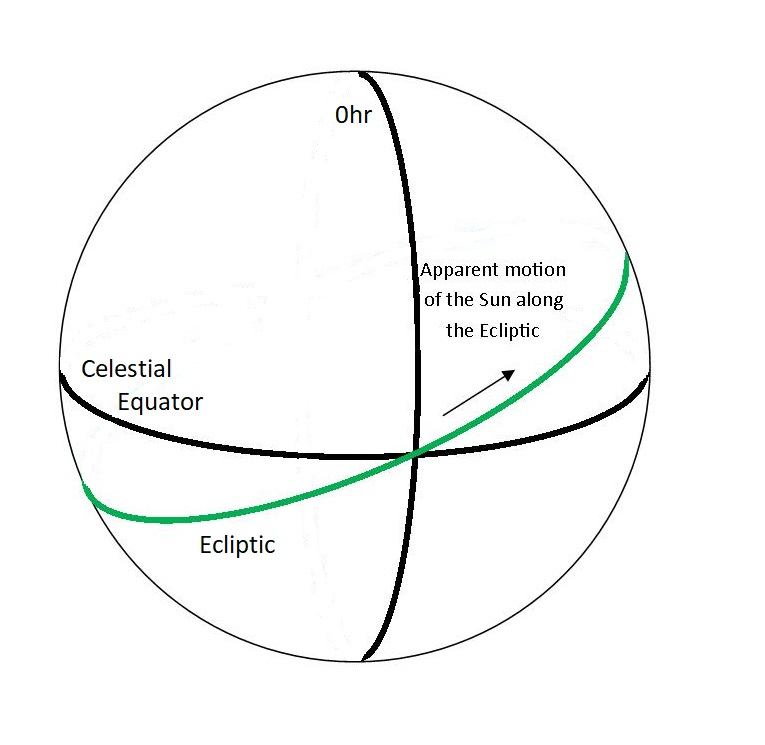
Notation
- Notation for RA and Dec coordinates may be written:
- 16h 29m 24.5s; -26o 25' 55".2
- 16 29 24.5; -26 25 55
- 16.4901389; -26.4320000
- The last form is decimal, useful for doing computations.
- There is a converter here: http://www.astrouw.edu.pl/~jskowron/ra-dec/
Measurements on the Celestial Sphere
- The separation between any two points on the celestial sphere is a measurement of angle.
- There are ninety degrees between the zenith and the horizon.
- A degree is subdivided into sixty arcminutes.
- An arcminute is subdivided into sixty arcseconds.
- A fist held at arm's length measures approximately ten degrees.
- There are more examples here: http://oneminuteastronomer.com/860/measuring-sky/
A coordinate example - Antares
Figure 4 below: A photograph from SkyAtlas 2000.0 by Will Tirion. RA coordinates are shown across the top of the chart and run from RIGHT TO LEFT. Dec is indicated down the right-hand side with increasing negative declination as you go from top to bottom. This part of the sky is in the southern hemisphere. The bright star, Antares, in the constellation of Scorpius, is labelled. Antares' celestial coordinates are, reading from this chart, approximately 16h 29m; -26o.
Image Credit: Photo by the Lesa Moore

3. Twilight, Twinkling and Which Stars You'll See
- Astronomical twilight ends about one-and-a-half hours after sunset (but this is latitude-dependent). It is not until after astronomical twilight that the sky becomes truly dark as, until then, there is still scattered sunlight in the atmosphere.
- The twinkling of stars is caused by air currents in our atmosphere - not just wind, but inversion layers, rising pockets of warm air, and other turbulent effects. Twinkling of stars is usually more noticeable near the horizon, due to the longer path length of starlight through the atmosphere as you get nearer to the horizon.
- Seeing refers to the steadiness and transparency of the sky. Seeing is affected by air currents and turbulence in the atmosphere, as well as particulates or pollution, and moisture content. On a night of good seeing, the atmosphere is particularly steady and clear.
Figure 5 below: The thickness of the troposphere (the lower part of the atmosphere where weather occurs) is about 10km. When viewing near the horizon, the line of sight has a long path through the troposphere. The shortest path is straight up so, generally, the best observing is overhead.
Image Credit: Diagram by Lesa Moore

- The field of stars that you'll see on any particular night depends on several factors:
- The stars that you may be able to see at any time of year will be limited by your latitude. Observers in Sydney, for example, will never see the star Polaris because it will always be below the horizon.
- The visible star field changes throughout the night, due to the spin of the Earth. Just as the Sun appears to rise in the east and set in the west through the daytime, most stars appear to rise in the east and set in the west at night.
- Some stars are circumpolar. Rather than rising and setting, they are close enough to the celestial pole to make small circles around the pole as the Earth spins. This effect is latitude-dependent. For example, the Southern Cross never sets from Sydney's latitude (provided that you have an unobstructed horizon to the south).
- Because we only see the stars in the part of the sky that lies away from the Sun, as the Earth orbits the Sun, the field of stars visible each night changes throughout the year (refer Figure 6).
Figure 6 below: As the Earth orbits the Sun, the night-time side of the Earth faces different directions in space, meaning that we see different stars at different times throughout the year.
Image Credit:Diagram by Lesa Moore

4. Dark Adaptation, Charts, Planispheres, Yearbooks and Atlases
- Dark adaptation refers to the ability of the human eye to adjust for different brightness conditions. Under bright light, the pupil contracts to limit the amount of light entering the eye, thus helping to protect it from damage. In the dark, the pupil opens wide and the chemistry on the retina also changes over a period of about 20 minutes - the eyes become dark adapted, allowing you to see in very dim light. If you go from a brightly-lit room out to a dark back yard, you will, initially, be "night blind" until your eyes become dark adapted. To preserve your dark adaptation, if you need to read a chart or find something in the dark, use a red torch (or a regular torch covered with a few layers of red cellophane). The eyes are least sensitive to red light and, by using red light, you are able to preserve your dark adaptation.
- A basic evening star chart, suitable for your own location and time of year, is available at http://skymaps.com/. Provided that you select the correct chart (Northern, Equatorial and Southern are available on the website for each month), the chart will show you the entire sky for evening viewing. It will also have a list of observing targets on page 2.
- A planisphere is a special kind of circular map that allows you to "dial up" which stars are visible any time of night, any time of year. However, it is latitude specific. A planisphere that works for southern Australia will be fine for South Africa and Chile, but no good for Hawai'i or England. There is a FREE beginners' planisphere, suitable for southern Australia, here: http://members.ozemail.com.au/~starrylady/StarryladyPlanisphere.pdf.
- More detailed atlases for the entire sky are available from astronomy retailers. The example, shown at Figure 4 above, is from one of these. Such atlases map the sky section by section.
- Individual constellation charts are available online from the International Astronomical Union (IAU) here: https://www.iau.org/public/themes/constellations/. There is an example below (refer Figure 7).
- Yearbooks are available as references for interesting events happening on certain dates. They normally list the phases of the Moon, describe where to find the planets and highlight any other special events such as eclipses. A version that is popular in Australia is from Quasar Publishing (available at a discount to ASNSW members).
- Charts and atlases are labelled according to epoch. Section 10, below, explains how Precession of the Equinoxes changes the positions of all the stars over time with reference to our RA and Dec coordinate grid. Star charts must be updated to reflect these changes. Two popular epochs are B1950 and J2000, the latter being adopted as the new standard by the International Astronomical Union (IAU) in 1984.
- Standard notation is used on most charts, with sizes of dots corresponding to star brightness, and special symbols being used for open clusters, globular clusters, planetary nebulae and galaxies. The Milky Way is often outlined and shaded, as are isolated nebulae emission nebulae. A sample chart of Scorpius from the IAU is shown below (refer Figure 7).
Figure 7 below: A chart of the constellation Scorpius
Image Credit:IAU

A big problem, if you are observing from the city, is light pollution. Light pollution is caused by street lights, lights from homes and cars, lights shining up into trees and onto buildings, advertising signs, and all forms of obtrusive light that illuminate dust and moisture in the atmosphere. This effect makes the sky bright where it should be black, thus making it more difficult to discern faint objects in the sky, such as the Milky Way, the Magellanic Clouds and the fainter stars. Through a telescope, nebulae and galaxies become more difficult to see. The solution is to get away from the city. Depending on the size of the city and the observing aspect, this may mean 20 to 50 kilometres away. The difference this makes is crudely illustrated in the next image (refer Figure 8). It gives an idea of the city view of the Southern Cross and Pointers and the country view of the same area of sky.
Figure 8 below: These photos of the Southern Cross (Crux), taken using a short exposure (top) and a long exposure (bottom, with star trailing) simulate the comparison between what you would see from a brightly-lit city and what you would see from the countryside. Note that from the country, the Milky Way and many more stars are revealed.
Image Credit: Photos by Lesa Moore
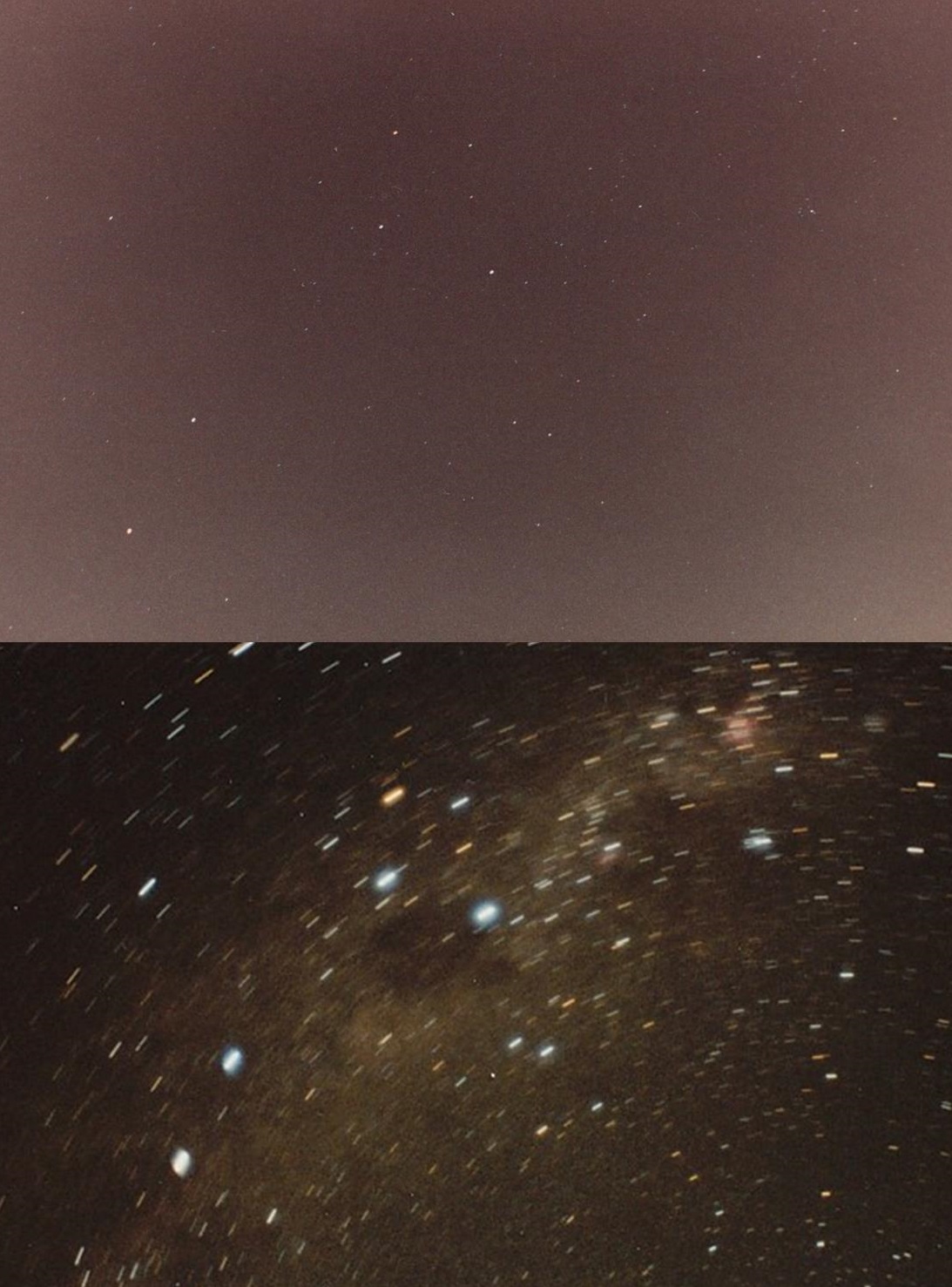
People new to astronomy may wonder why they can't go outside and just see some celestial object or scene that they have seen in a magazine. Magazines publish images that have been made with a camera (or camera and telescope). Those photographic images have been accumulated over a period of time. In the days of film photography, exposures that lasted an hour or more may have been made, using a camera that would track the stars as the Earth was spinning. Modern digital cameras are also able to take long exposures. A more common practice is to take many shorter exposures and combine them together in a computer to improve the contrast and detail in the image, showing faint stars, nebulae and galaxies.
The eye, on the other hand, is virtually an instantaneous detector. The refresh rate for the retina is measured in milliseconds, before that signal is sent to the brain and the next "exposure" is made. Your eye is unable to save up the light over a long period of time to manufacture an image of faint objects. Thus, naked-eye astronomy is limited to the brighter objects - the Moon, planets, stars down to magnitude 6, a few large open clusters and globular clusters, and the brightest galaxies - the Milky Way, the Magellanic Clouds and the Andromeda Galaxy.
If you compare what you see through a telescope with a photograph of the same celestial object, you will discover that the picture does not accurately represent what you see. There is another important difference between the eye and a camera. The camera is a linear detector, whereas the eye is a logarithmic detector. All this means is that the response of a camera increases directly in proportion to the amount of light, sometimes resulting in saturation of the brightest areas of an image. The eye, however, is able to see really faint things right alongside really bright things, without the problem of saturation. It is basically working harder to see the faint stuff and is able to turn down the response to the bright stuff so that you can see it all, at least in the context of the overall low light level you are getting with night-sky objects. The only way to accurately represent what you see is with a sketch. Many examples and comparisons are available online. There is a nice comparison of sketch and photo of the Swan Nebula here.
As illustrated in Figure 6 above, the constellations that you will be able to see change throughout the year. From Australian latitudes, there are some objects and constellations that are all-time favourites. The best times of year for observing these in the evenings are listed in the table below, though this list is far from comprehensive. Early risers should consult a planisphere (refer Section 4 above) for morning availability.
| Months (season) |
Constellation | Popular Objects |
| November to April (summer) |
Orion (Photo below, Figure 9) |
The Great Orion Nebula, M42 |
| February to June (autumn) |
Leo (Photo below, Figure 10) |
Numerous galaxies |
| February to September (autumn - winter) |
The Southern Cross (Crux) (Photo above, Figure 8) |
The Jewel Box (an open cluster) |
| February to September (autumn - winter) |
Centaurus | The "pointers" - alpha and beta Centauri Alpha Centauri - a famous double star Omega Centauri (a globular cluster), NGC 5139 |
| April to September (winter) |
Scorpius and Sagittarius (Photo below, Figure 11) |
The centre of the Milky Way |
| June to September (winter) |
Lyra | The Ring Nebula (a planetary nebula), M57 |
| November (spring) |
Andromeda and Pegasus | The Andromeda Galaxy (a spiral galaxy), M31 |
| October to February (spring - summer) |
Dorado & Mensa, Tucana (Photo below, Figure 12) |
The Magellanic Clouds (nearby irregular galaxies) 47 Tuc (a globular cluster), NGC 104 |
Many more constellations and hundreds more objects are available to southern observers. Discovering them in various ways is one of the joys of amateur astronomy.
Figure 9 below: Orion, as seen in the west when setting. This image exhibits star trailing as it was a five-minute exposure with film.
Image Credit: Photo by Lesa Moore

Figure 10 below: Leo, the lion, appears upside-down for southern observers.
Image Credit: Photo by David Malin
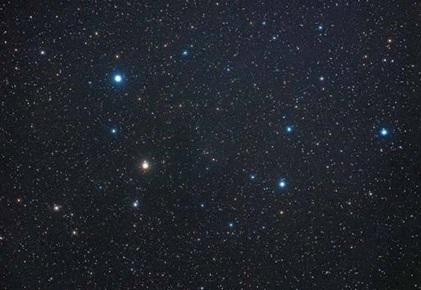
Figure 11 below: Scorpius above the clothesline. Of all the constellations, this is the one that best resembles the thing that it is meant to represent. A bright planet is also visible below the "head" of the scorpion on the left side of the image.
Image Credit: Photo by Lesa Moore

Figure 12 below: The Large Magellanic Cloud is the fuzzy patch to the left of the roof. Also note that the amount of star trailing decreases as you get closer to the South Celestial Pole.
Image Credit: Photo by Lesa Moore

8. Eye vs. Telescope and Averted Vision
The reasons for using a telescope are multiple. Many would think that it is all about magnification, but this is not the most important way that a telescope helps you to see celestial objects. Consider the pupil of your eye - that little black bit in the middle of the iris. The pupil is not solid, but is the window that lets light pass through to the retina at the back of the eyeball. The iris controls the size of the pupil, which enlarges in low-light conditions so that you can see better in the dark. There is a limit, however. The maximum pupil size decreases with age but is only around 7mm in diameter when fully open. A telescope can be thought of as a giant pupil - maybe 150 to 300 mm in diameter or even larger.
There are two primary advantages in using telescopes:
- Telescopes gather more light, so you can see fainter things with a telescope.
- Resolution is directly proportional to the diameter of the telescope, so you can see more clearly with a telescope.
For both these reasons, larger-diameter telescopes are better, and certainly reveal more than the naked eye can see. High magnification is only useful if you already have a well-resolved image. There will be more on this topic in a later online module.
One other trick is useful to know, and it's to do with the way your eye works. The light detectors on your retina are rods and cones. The cones detect colours and the rods only see in black and white. At the fovea (the part of the retina that is exposed when looking at something directly in front of you), there is a high concentration of cones and almost no rods. This allows you to see the greatest detail in the daytime if, for example, you need to get out a splinter. However, the cones don't work in low light conditions, leaving your central vision deficient at night. Astronomers use a trick called Averted Vision. Use this when looking at something very faint in the centre of the field of view at the eyepiece. If you are meant to see something, but you can't, try aiming the eye slightly to one side of the centre. The object will become more apparent in your peripheral vision. Unfortunately, looking straight at it again, it is likely to disappear! This does, however, allow you to see more than you would otherwise be able to with a direct gaze through the eyepiece.
When you do look through a telescope, you must appreciate that the field of view is quite small - smaller than you would see through binoculars. The examples below gives you some idea of the different scales that apply when observing naked-eye and observing with a telescope.
Figure 13 below: Zooming in on M7, an open cluster in Scorpius
Image Credit: Photos by Lesa Moore
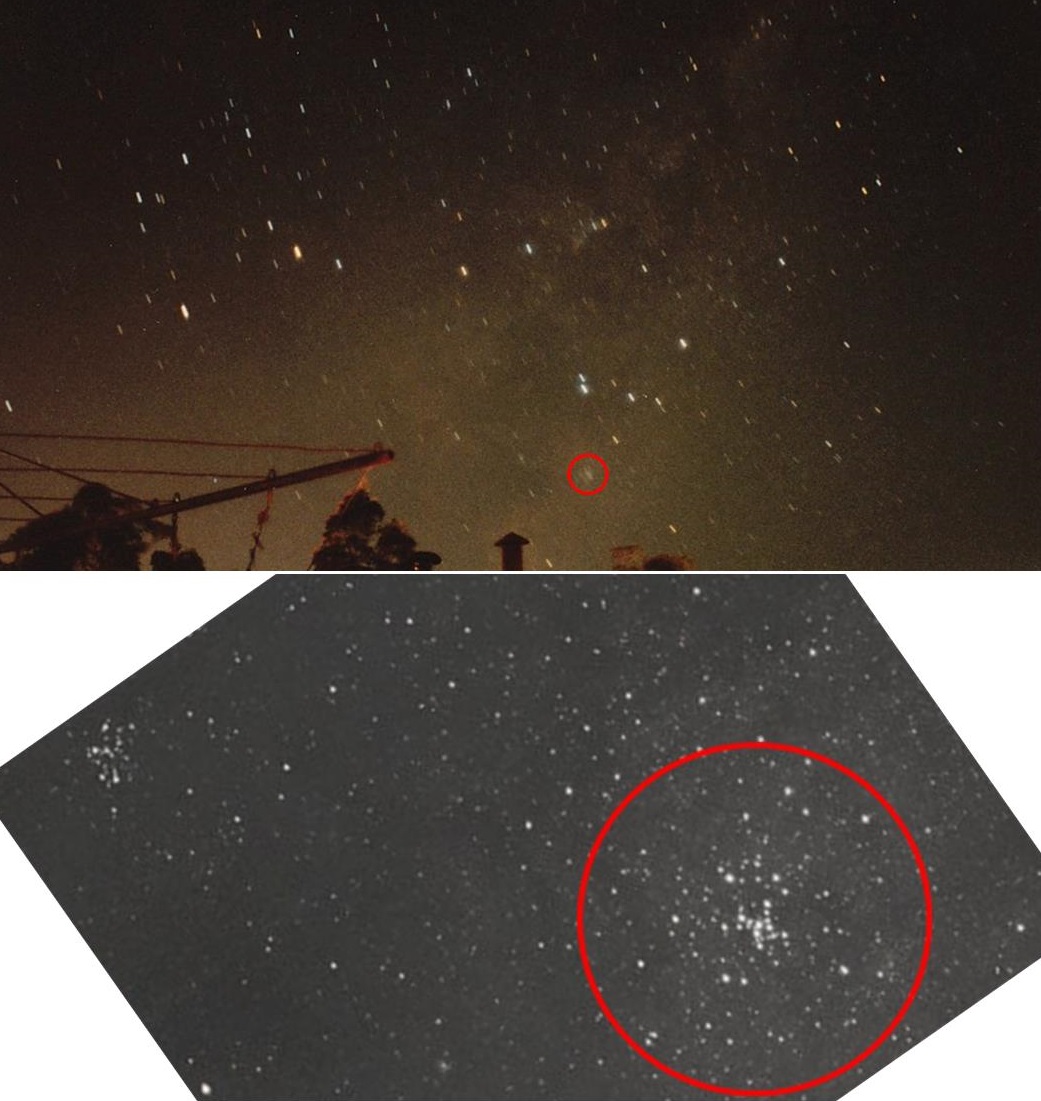
Figure 14 below: Zooming in on Omega Centauri, a globular cluster in Centaurus
Image Credit: Photos by Lesa Moore

There are 88 constellations in the sky, but people are probably most familiar with the names of the ones that appear in horoscopes: Aries, Taurus, Gemini, Cancer, Leo, Virgo, Libra, Scorpius, Sagittarius, Capricornus, Aquarius, Pisces. These twelve constellations are collectively known as the Zodiac and lie along the part of the sky traversed by the Ecliptic. This means that the Sun spends some time in each of these constellations, which is why they hold significance for astrologers.
Bear in mind that, in ancient times, astrologers and astronomers were the same, since people with an understanding of the sky were able to make predictions of the phases of Moon, lunar and solar eclipses, the passage of the naked-eye planets through the constellations and the return of seasonally-visible constellations. Astronomers were able to make "prophecies" of these events and were credited with other powers as well.
In modern times, astronomy and astrology have diverged. Astronomy today is a science that studies celestial objects to learn about their appearance, composition, evolution, motion and history. Whilst astrologers divide the Zodiac into twelve equal "signs", the constellation boundaries were formalised by the IAU in 1930. Since the drawing of those boundaries, part of a thirteenth constellation, Ophiuchus, now also lies on the Ecliptic.
Familiarity with the Zodiac constellations and the Ecliptic is useful for amateur astronomers. The Sun appears to follow the Ecliptic. The rest of the planets of the Solar System follow orbits in planes very close to the Ecliptic. So, if you see a bright object in a Zodiac constellation that is not shown on your star chart, it will almost certainly be one of the naked-eye planets (Mercury, Venus, Mars, Jupiter or Saturn). Observing the planets will be discussed further in Part 5.
Figure 15 below: The original Zodiac constellations and the path of the Earth around the Sun (not to scale).
Image Credit: Diagram adapted by Lesa Moore">
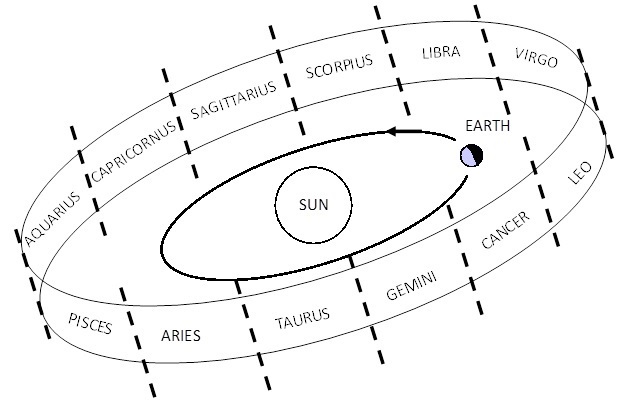
10. Precession of the Equinoxes
Earlier, it was mentioned that different epochs are used for star charts. The reason for this is that the Earth's spin axis does not always point at the same direction in space. Yes, as the Earth goes around the Sun, the axis points in the same direction, causing the seasons. Over the span of a year, the change in direction of the spin axis is minuscule. However, over a period of 26,000 years, it makes a complete circle in its cycle of precession.
Precession is something that happens to unbalanced things that spin. Most readers would be familiar with the behaviour of a spinning top. When spinning rapidly, the top remains vertical. As it begins to slow down, the axis tilts and begins to wind around, making the top appear wobbly. This is precession. Eventually, the top loses all its spin energy to friction and it falls onto the table. In the case of the top, gravity is trying to made the top fall down but, because it has so much spin energy - angular momentum - it can't fall straight down and precesses instead.
Why does the Earth's axis precess? The Earth is not a perfect sphere. It is an oblate spheroid (i.e., it has a bit of a bulge around the middle). The gravitational pulls of the Sun and the Moon on the Earth are trying to pull it upright! Again, the Earth has too much angular momentum and won't stand up straight, but precesses instead. Yes, the Earth wobbles! The effect on the Earth is known formally as Precession of the Equinoxes.
Figure 16 below: Precession of the Equinoxes is the wobble of Earth's axis with respect to the stars.
Image Credit: Diagram adapted by Lesa Moore

Consequences of Precession of the Equinoxes:
Figure 17 below: Chart detail showing the amount of precession between 1950 and 2000.
Image Credit: Diagram by Lesa Moore

- Separate grids: Our coordinate system of RA and Dec is based on the position of the Earth in space. In particular, the poles are in the direction of Earth's spin axis. Something that doesn't change with Precession of the Equinoxes is the plane of Earth's orbit around the Sun. Therefore, the Ecliptic remains in the same place with respect to the background stars. The stars also remain in the same positions with respect to each other. Precession only makes the Equatorial Coordinate Grid move around with respect to the everything on the celestial sphere.
- Changing the maps: The wobble of Earth's axis takes roughly 26,000 years to complete one cycle. Over a time periods of 50 years, the effect is noticeable and astronomers need to update their charts to be able to use accurate coordinates to find stars and other objects.
- The Vernal Equinox: The First Point of Aries is defined as the point where the Sun appears to cross the equator when heading north. This position on the sky, as well as the time of year, is called the vernal equinox. The position is used to mark the 0h RA line. Precession gradually moves the Ecliptic around the celestial equator, changing where the 0h RA line has to run. It is the reference to the position of the vernal equinox that gives rise to the name "Precession of the Equinoxes".
- The Pole Stars: Polaris, which is a star that is very close to the North Celestial Pole (and is known as the Pole Star) will not always be the north's Pole Star. Similarly, in the south, the South Celestial Pole currently sits in a region with few and faint stars. At some point, we should have the bright star, delta Velorum (magnitude 1.93), as our southern Pole Star (at least, it will be almost as close as 11 arc minutes away from the South Celestial Pole in 9295 AD - with thanks to Andrew James for this prediction).
- Seasons still work: At this point, it may seem that eventually the seasons would get out of step and, that in 13,000 years' time, we'd be having Christmas in winter in Australia. However, this won't happen because our year is measured in such a way that our seasons keep time with the calendar throughout the precession cycle.
- The Zodiac: Although the Ecliptic remains in place compared with the stars, the times of year when we see the Sun in those Zodiac constellations will gradually change. The calendar is matching the seasons, not the stars. Currently, the dates are out of step with the Zodiac by about one month, or one star sign! This has occurred since the Zodiac was first designed, more than 2000 years ago. The Vernal Equinox, or First Point of Aries, despite its name, is no longer in Aries but is in Pisces. The next constellation that it will move into will be Aquarius. This is the origin of the song line about "the dawning of the Age of Aquarius" (from the musical, "Hair).
Figure 18 below: Chart showing the position of the First Point of Aries over past and future millennia. Around 2200 years ago, the First Point of Aries was only just in Aries. It has been in Pisces ever since (recalling that constellation boundaries were not well defined at that time). In another 600 years, it will move into Aquarius.
Image Credit: Quora https://www.quora.com/
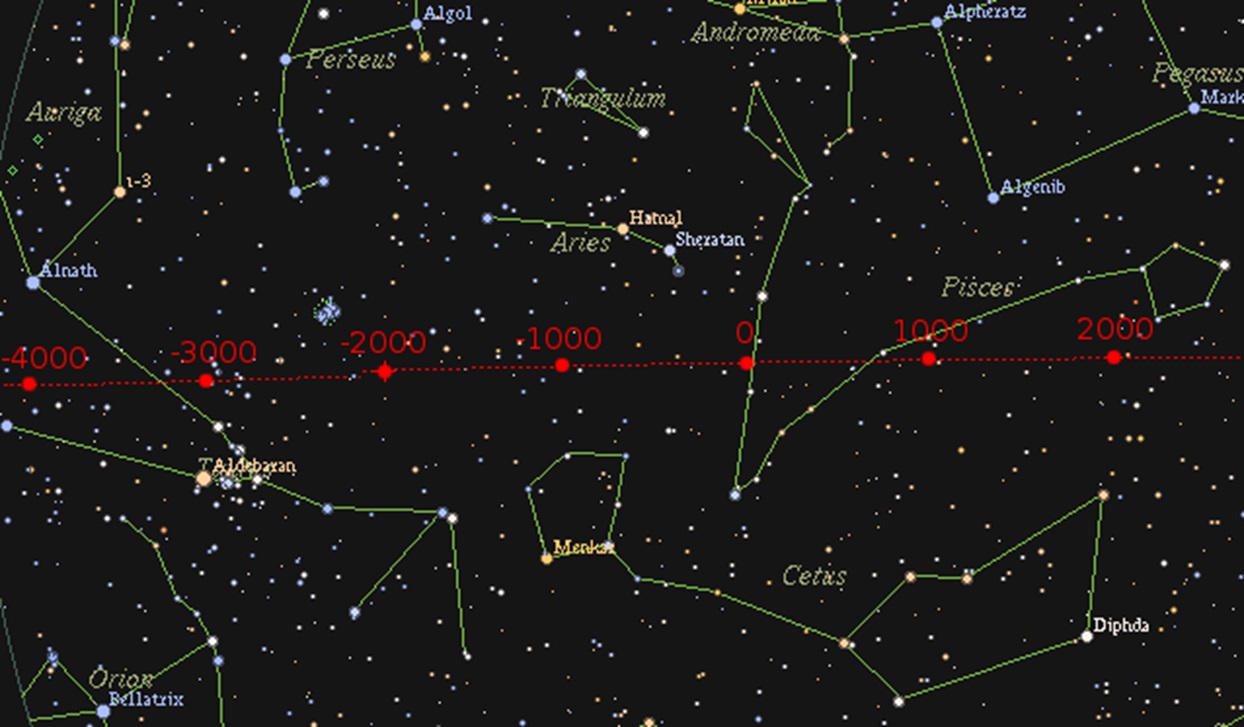
At this epoch, we can relist the Zodiac constellations, the dates when the Sun is actually in each constellation and include Ophiuchus which, since 1930, also lies partly on the Ecliptic.
Figure 19 below: This table gives dates when the Sun is really in each constellation and, also, the number of days it spends in each constellation. Ophiuchus became part of the Zodiac in 1930, when the IAU drew formal boundaries around the constellations. Prior to this, only the constellation "stick figures" were used.
Image Credit: Table by Lesa Moore
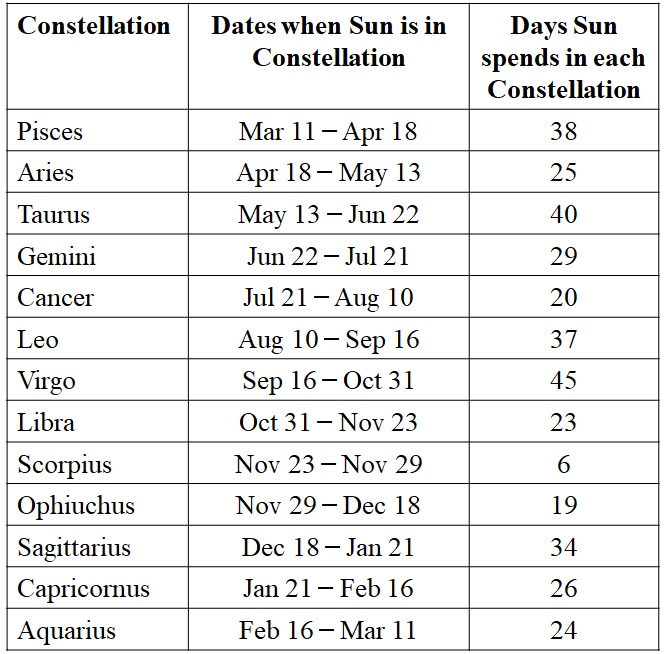
11. Finding South with the Stars
Two imaginary lines may be drawn through the Southern Cross and between the Pointers. These two lines meet at the South Celestial Pole (SCP). From there, drop a line straight down to the horizon. This is the location of true south, as it would appear on a map or an atlas. This method works any time of year, as long as the Cross and Pointers are visible above the horizon (i.e. there are no trees or buildings in the way). The stars are circumpolar from southern Australian latitudes and move around the SCP like hands on a clock face. The SCP is like the centre of the clock - the two lines always meet in the same place, no matter which way up the stars appear.
Figure 20 below: Finding South with the Southern Cross and Pointers
Image Credit: Diagram by Lesa Moore

The best locations have:
- Dark skies
- Cool, dry air
- Little or no cloud cover
- Not much wind (a perimeter of trees can help)
Avoid:
- Cities, household and neighbours' lights
- The seaside (salt spray can build up on telescope mirrors and cause poor seeing)
- High-wind locations (wind can move telescopes and binoculars)
Author: Lesa Moore, 2nd February 2018, revised 28th May 2019 (with thanks to Andrew James for his constructive feedback).

